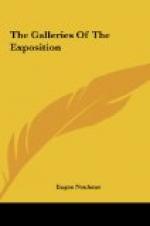reminded of the fact that though a people of the sea
the Dutch do not seem to possess a single strong marine
painter. One looks in vain for any pictures of
the open sea reflecting the seafaring traditions and
activities of the Dutch, and if it were not for Mastenbroek’s
masterly harbor pictures, one would have to console
oneself over this lack of the briny element with a
view of the Amsterdam Marine Aquarium. Mastenbroek’s
big canvas is full of life and well painted. It
shows the harbor of Rotterdam animated by a host of
vessels of all kinds and descriptions. While
there is a fine feeling of loose accidental arrangement
about this big picture, it is nevertheless well composed.
His small canvas in the adjoining gallery is technically
superb, and to my mind the best canvas in the whole
Dutch show. In the middle of the same wall Gorter’s
very decorative autumnal landscape, of a group of
beech-trees, commends itself by an unusual feeling
for colour and design, so lacking in the two almost
monochromatic, untemperamental Witsens on either side.
Almost opposite in the same gallery, the most western
in the Netherlands section, hangs a broadly painted
canvas by Breitner, of the timber harbor of Amsterdam.
It is not so original a subject as one is accustomed
to see from Breitner, but fully deserving of the best
place on the wall. Thérèse van Duyl-Schwartze’s
portrait alongside is equal to her usual performances,
and very broad in style and full of vigor. Jurres’
“Don Quixote”, Goedvriend’s little
canvas, and Bauer’s “Oriental Equestrian”
should all be mentioned in this gallery.
In the middle gallery, on the right of the big Mastenbroek,
Christian Addicks’ “Mother and Child”
charms by its richness of colouring, while in the
left corner hangs a very decorative still-life in the
best manner of such old Dutch painters as Hondekoeter.
Nicolaas Bastert has a typical Dutch canal, and Willy
Sluiter a good study of a Volendam fisherman.
One gallery is entirely devoted to etchings, woodcuts,
and mezzotints, and the standard maintained in this
gallery is high. Martinus Bauer’s three
etchings are among the finest to be seen anywhere
in the exhibition, and the work of Harting, van Hoytema,
and Haverman do not fall much below his standard.
There is young Israels (Isaac) with some very snappy
sketches. Nieuwenkamp is intensely interesting
in the few things he has there, with a certain sense
of humor which is conspicuous for its absence in most
Dutch work. The woodcuts of Veldheer are vital
and unusually free from any academic feeling.
Considering the relative size of the Netherlands,
they have a remarkably large number of artists, but
scarcely of sufficient bigness of caliber and independence
of character to live up to the traditions of this people.
Germany




